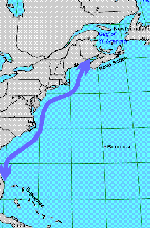 |
 |
 |
 |
 |
 |
 |
Right Whale Migration Update: April 11, 2001
Todays Report Includes:
- Greetings from the Stellwagen Bank National Marine Sanctuary -
- Challenge Question #11
- Subsurface Feeders Not Easily Seen by Ships
- End of the Season Report from the Calving Grounds
- The Number is Now 30-31 Mother/Calf Pairs!
Greetings from the Stellwagen Bank National Marine Sanctuary-
Right whales, for the most part, are numbered (only a few are given word names like the humpbacks). The mothers seen to date are: 1703 (which has been seen before in Cape Cod Bay), 1602 (which is known to have had one other calf which it brought back to Cape Cod Bay), and possibly a whale named "Punctuation" (but this has not yet been confirmed). The first mother-calf pair was sighted on March 26, with the others found during a patrol on April 4. In addition to the mother-calf pairs, many other whales (males and females, adults and juveniles) are still feeding in Cape Cod Bay, and occasionally on Stellwagen Bank.
Pull out your maps and answer this:
Challenge Question #11:
"A patrol boat found 10 whales on April 9, in Cape Cod Bay in the vicinity of 41.867N, -70.383W. Why might this position be of concern to right whale researchers and marine mammal protection specialists?"
(To respond to this question, please follow
the instructions below.)
Subsurface Feeders Not Easily Seen by Ships
Marilyn Marx, a researcher with the New England Aquarium Right Whale Research Group, knows the whales and sends a warning report. She reports that many (all but 5 or 6) of the new mothers are INSHORE mothers (whales that have been commonly seen in Cape Cod Bay and/or the Bay of Fundy, as opposed to more offshore, open ocean residents). As food appears to still be plentiful in Cape Cod Bay (based on the continued sightings of feeding whales and plankton surveys by the Center for Coastal Studies), researchers expect many of these mothers and calves to make appearances in Cape Cod Bay soon. One problem with the food source, however, is that the plankton patches are subsurface. That means the whales are feeding at some 5-6 feet below the surface of the water - making them invisible to surface ships except when they come to the surface to breathe. Air patrols easily see them (they can see down into the water column). If the food supply holds out, researchers foresee an interesting upcoming month.
End of the Season Report from the Calving Grounds
New England Aquarium's Chris Slay has filed his last report of the season from the winter calving grounds. It was an exciting and bountiful year in the protected waters. Here are some of the highlights:
"Calving Ground, 03/30/01
The last whales seen down south were sighted on consecutive days last weekend, at the north end of our survey area, making steady progress to the north. These two mother/calf pairs will be navigating some tough areas going back to New England, including the mouth of Chesapeake Bay, near the beach where a ship-killed calf stranded two weeks ago. This male calf was already 25' long, probably 7'-8' longer than when it was born less than 4 months ago. Amazing. Hate to lose such a robust addition to the species. That leaves us with 24 moms and calves, eventually bound for the Bay of Fundy. It should be a wild summer there.
Counting calves, more than 62 right whales were identified in our little patch of water, including all but one of this year's 26 newborns. That's almost cause for celebration, which reminds me, I'd better get on down the road.
Chris Slay"
The Number is Now 30-31 Mother/Calf Pairs!
We've also received additional positive news from the New England Aquarium's Right Whale Research Group. They have received new photos from southern waters (images from the NEAq's Early Warning System inshore overflights, the Georgia Dept. of Natural Resources offshore patrols, the Florida Marine Research Institute surveys and surveys by the University of North Carolina-Wilmington). These pictures show more mother-calf pairs than had been previously counted. The number is now up to 30 or 31 pairs, with the possibility of even more calves (as all of the photos have not yet been examined). This is definitely a record year for right whale births (there was 1 calf in 2000, 4 in 1999, 6 in 1998). Some of the whales are probably still down south, but most are making the northward migration right now. Here's hoping that they make the voyage past the many busy east coast ports uneventfully and safely.
That's all for now. This is Anne Smrcina, education coordinator of the Stellwagen Bank National Marine Sanctuary, signing off.
How to Respond to Today's Right Whale Challenge Question:
IMPORTANT: Answer only ONE question in each e-mail message.
1. Address an E-mail message to: jn-challenge-rwhale@learner.org
2. In the Subject Line of your message write: Challenge Question #11.
3. In the body of the EACH message, give your answer to ONE question above.
The Next Right Whale Migration Update will Be Posted on April 25, 2001.
Copyright 2001 Journey North. All Rights Reserved. Please send all questions, comments, and suggestions to our feedback form
 |
 |
 |
 |
 |
 |

